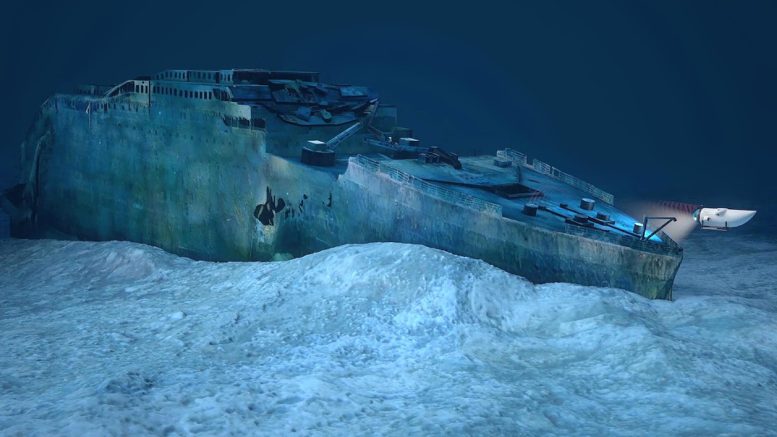The submersible “Titan,” meant to survey the Titanic’s wreckage, ended in tragedy when it imploded, taking five passengers with it. This sparked a discussion on what motivates people to undertake such perilous adventures, with factors ranging from seeking arousal and overcoming fear, to enhancing self-esteem and the pursuit of wonder and awe. Credit: OceanGate Expeditions
The submersible “Titan,” carrying five passengers on a $250,000 expedition to survey the Titanic’s wreckage, catastrophically imploded, sparking a conversation on why people take such risks. Factors include the desire for arousal, conquering fears, self-esteem boosts, social status, and the pursuit of wonder and awe, says psychology professor Ajay Satpute.
The price tag for the trip was reportedly $250,000. The accommodations were cramped, and the destination was roughly 2½ miles below the surface of the cold, remote North Atlantic. Then there was the liability waiver that reportedly mentioned the risk of death three times on its first page alone.
What could have motivated the passengers on the submersible “Titan” to take such a risk?
“Why did that one person do that one thing in this case, it’s really hard to know,” says Ajay Satpute, an assistant professor of psychology at Northeastern University who studies fear. “But at least when it comes to the choice of rationalizing what we do, we will use many different reasons to do that.”
The “Titan” submerged Sunday morning, June 18, and its support vessel lost contact with it about an hour and 45 minutes later, according to the Coast Guard. Five people were aboard the craft, which was launched to survey the wreckage of the ocean liner Titanic.
The missing submersible set off an international search-and-rescue mission that captivated the world’s attention. On June 22, Thursday afternoon, however, the Coast Guard said that debris found earlier that morning was from the Titan and “was consistent with a catastrophic implosion of the vessel.”
OceanGate Expeditions, a private company that organizes and runs trips on the Titan, said in a statement that same afternoon that it believed the passengers “have sadly been lost.”
Satpute cautioned that individuals’ motivations and decision-making can be vastly different. Moreover, psychological studies have not been conducted involving fear and deep-sea submersibles.
“It’s hard to study some of these things because these are tragedies,” Satpute says.
However, Satpute notes that psychologists have studied connections between fear and arousal and extreme sports participation, haunted houses, and more. He says there are several factors that could influence a person’s decision to take such a risk.
The first is seeking that ultimate state of arousal—the perfect balance between feeling the rush of uncertainty and the comfort of safety. For example, Satpute referenced a rollercoaster ride.
“We think it’s going to be safe, but it’s meant to introduce some uncertainty as to where the body goes next—and that is arousal building,” Satpute said.
Another possible reason is a wish to establish mastery over something that is negative—a feeling of conquering a fear or learning how to survive a negative stimulus. Do you watch a horror movie to prove to yourself that you can make it through, for instance, or see a car accident and think about what not to do when driving?
“We think it’s going to be safe, but it’s meant to introduce some uncertainty as to where the body goes next—and that is arousal building.”
— Ajay Satpute, an assistant professor of psychology at Northeastern
“It’s something the brain might want to do,” Satpute says. “A way to learn how to survive.”
There are also issues of identity that can be associated with taking risks. Psychologists, for instance, have measured boosts to self-esteem when some people put themselves through risky experiences. Or maybe there are social motives—the ability to talk about things that nobody else can talk about—or extreme risk-taking could be related to conspicuous consumption or doing something unique that confers an elite or wealthy social status.
Finally, there is seeking wonder and awe. To see the wreckage of a 20th-century ocean liner suddenly appearing in the murky depths of the ocean could certainly induce those emotions.
Of course, not all factors are necessarily present in each person, or in each situation when they are taking a risk. Different factors may also be more prominent in one person than another.
“The motives will be person-dependent and probably situation-dependent,” Satpute says.
And individuals have different reactions to stimuli.
Do you visit the Titanic site for fun? Like a haunted house? After all, that can yield an emotional response that Satpute called the “joy of relief”—you willingly go there, feel happy but also anxious, but then afterward your happiness increases and your anxiety goes down
“You know it’s OK,” Satpute says.
Or do you visit the Titanic site to feel a sense of remembrance and solemnity? Like visiting the site of the 9-11 Memorial and Museum.
Or is it some of both?
“There are so many different possibilities that we don’t know,” Satpute says.
Read More:
Physicist Explains How Titan’s “Catastrophic Implosion” Happened – And What It Meant for Those on BoardPhysicist Explains Why the Titan Submersible’s Carbon Fiber Was Ineffective
>>> Read full article>>>
Copyright for syndicated content belongs to the linked Source : SciTechDaily – https://scitechdaily.com/titanic-risks-why-would-anyone-get-in-a-submersible-and-travel-2%C2%BD-miles-deep-into-the-ocean/





















